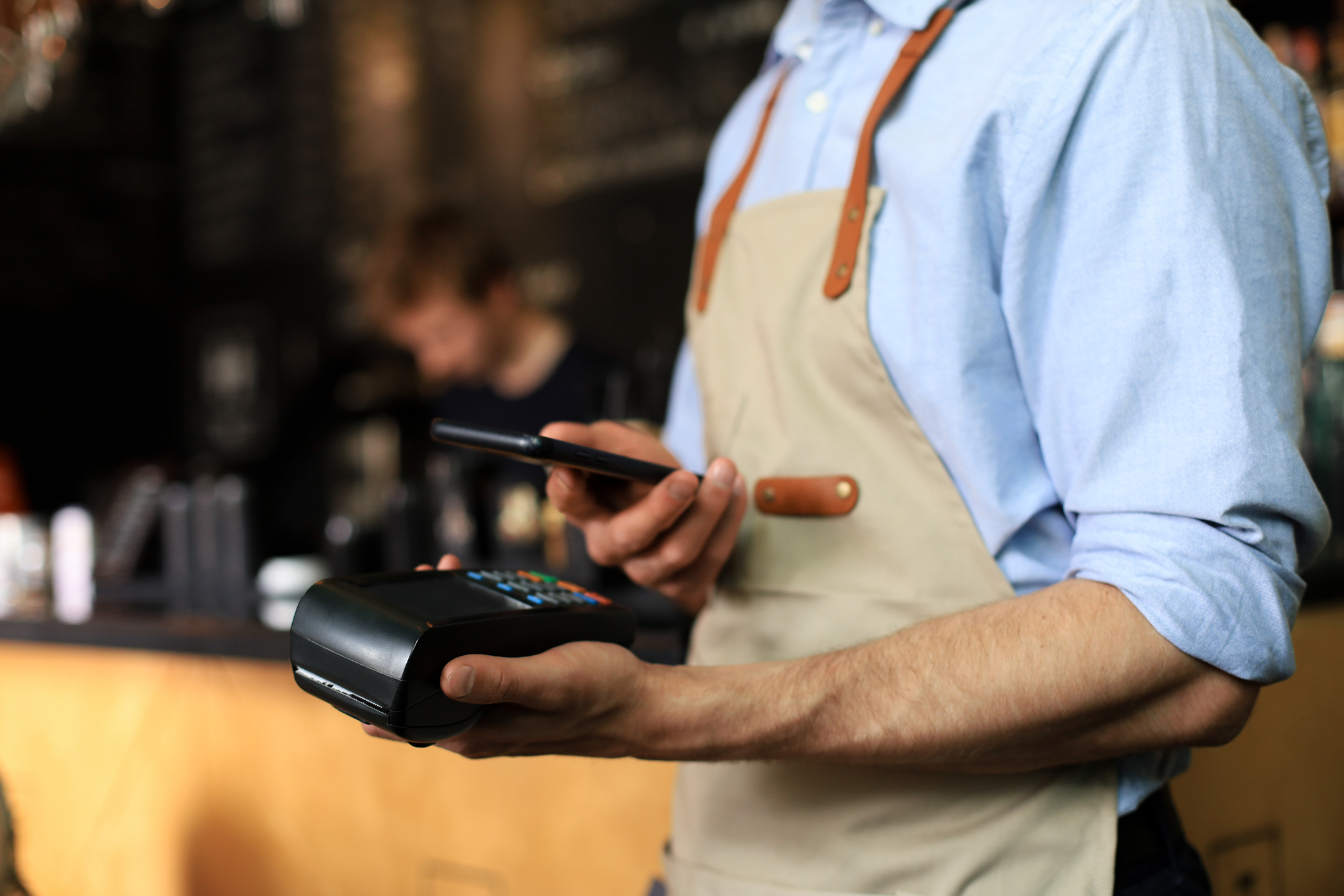The restaurant industry was one of the hardest hit by the pandemic. One in four jobs lost during the pandemic were in the restaurant industry—the highest number among all sectors in the economy. The good news is restaurants are adapting, changing the way they operate their businesses and how they serve customers.
Innovative commercial kitchen technology and smart dining are the new normals for the industry. Smart restaurants are proving it is possible to survive and thrive, even as the pandemic rages on.
Learn about the IoT technology making restaurants (and their owners) smarter, and 9 ways you can start benefiting from it today.
The IoT technology powering smart restaurants
Mobile point-of-sale (POS) systems
Mobile POS systems enable servers to communicate with the back kitchen instantaneously via a handheld tablet. The wait staff no longer has to write down or remember orders, and then key them in on a centrally-located POS system shared by all servers.
A mobile POS supports social distancing among the staff (they’re not all crowding around the same computer to punch in orders), and it streamlines the ordering process, getting information to the kitchen faster. Some mobile POS systems are also equipped with the ability to accept credit card or mobile payments, speeding up the checkout process.
Table Management Systems
Table management systems aren’t a new restaurant automation technology, but smaller restaurants are now starting to adopt the tech that larger chains have been using for years. Table management systems make it possible for diners to make reservations and put their name on a waitlist for a table. Some systems also include the ability to create a floor map of the restaurant to mark off sections for seating purposes.
Many diners prefer the ease of making reservations online, and it frees up greeters to focus more on customer service rather than writing down names.
Self-service tablets and kiosks
According to a recent report by Hospitality Technology, 30 percent of restaurants are adding kiosks. More than a quarter of restaurant-goers will select one restaurant over another based on whether it provides interactive kiosks.
Self-service tablets and kiosks allow customers to place their orders themselves and, in some cases, pay for them right at the table, without having to interact with a server. While some people still prefer a human server (especially in higher-end restaurants), the ability to place your order without human interaction makes social distancing possible in indoor restaurants.
Some features to look for in self-service tablets and kiosks beyond basic menu offerings are the ability to customize dishes and add notes (especially for food allergies), real-time updates on orders, and the option to leave feedback. If you’re looking for some inspiration, check out what Red Robin is doing in this space, offering music and games to diners while they wait.
Mobile apps
2020 taught us that restaurant apps are critical for survival. Customers want the convenience of placing an order online, so they don’t have to wait in line for pickup.
Mobile apps for restaurants also allow customers to order ahead, select a time for pickup or delivery, and save certain items as “favorites” to make future orders faster. Diners can make reservations online, put their names on a list for a table, and earn rewards for being loyal patrons.
Many diners are quick to place a take-out order through UberEats or Doordash. But most of these third-party delivery apps charge a hefty commission (anywhere from 15 to 30 percent per order). So while we think we are supporting our favorite restaurant, owners are giving away a sizable portion of their revenue to delivery services.
While restaurant owners can’t expect their customers to give up this convenience, they can take it in-house, by building an automated restaurant ordering system into their mobile app and website. Restaurants can even offer customers the option of planning out meals in advance for delivery.
This enables restaurant owners to optimize inventory while adding even more convenience to the customer experience. Customers can place orders, purchase subscriptions, and schedule deliveries—cutting out the middleman. Pre-ordering allows restaurants to plan ahead and lock in predictable revenue.
Robots
Believe it or not, robot chefs are making pizzas and burritos just as well as humans. They are replacing line cooks in a number of establishments, saving money on labor without sacrificing quality.
Robots kiosks and vending machines are also becoming a popular secondary revenue source for restaurants. Robot kiosks are, in essence, miniature versions of a restaurant, able to operate in airports, hospitals, offices, and more.
Chowbotics has a robot named “Sally” that prepares salads and other bowl-style meals in hospitals, grocery stores, and universities. Ingredients are stored in canisters and mixed according to the customer’s specifications. Sally offers convenience, customization, and improved food cleanliness. Wilkinson Baking Company employs a BreadBot that makes fresh bread entirely on its own.
Smart sensors
IoT sensors are ideal for monitoring ingredient inventory. They are also perfect for monitoring the health of other smart kitchen assets, such as robot chefs, or the more mundane equipment, such as refrigeration units. Sensors can alert managers if a particular piece of tech is in need of maintenance, so it can be addressed before it interrupts production.
Nine benefits of smart restaurant adoption
1. Frictionless customer experience—Diners spend less time waiting around for a table, can place their orders more quickly, receive their food faster, and can pay their bill more quickly. Tabletop tablets allow patrons to ask for a refill or more napkins without having to wait for their server to stop by and ask how things are going. Smart restaurant technology vastly improves (and even removes) many of the small nuisances that sometimes occur when dining out. And, as people remain vigilant about social distancing, contactless dining technology is an added draw for patrons.
2. Faster food prep time—Automation speeds up the food preparation process. Added benefits include standardization and quality. If owners want to make sure certain items are prepared a very specific way, smart technology can ensure standards are met and measure results to make sure they are maintained over time.
3. Improved table turnover—Faster ordering times and meal prep means patrons can “eat up” in less time. This is critical during peak dining times when wait times tend to increase. Restaurants have a lot to gain by earning a reputation for shorter wait times and faster food service.
4. Reduced dependency on human labor—It can be hard to find highly qualified chefs and cooks. Automation such as robot chefs reduces the number of cooks needed in the kitchen. Smart technology can also assist humans in the food prep process, enabling less-skilled workers to prepare food items without sacrificing quality. Self-service kiosks and other automated food ordering systems reduce the reliance on hostesses and servers, making it possible to maintain operations with fewer people.
5. Improved health and safety—Robots and other automated commercial kitchen technology can take over more dangerous tasks associated with restaurants. When robots take over some of the work done with extremely hot ovens, multiple burners, and open flames, there is a reduced risk of kitchen mishaps such as burns. Reduced handling of ingredients by cooks also improves food safety, which is more important than ever.
6. Stronger customer loyalty—Restaurant apps make it easy for diners to make reservations and avoid waiting for a table. Owners can use the app to promote special events and offer discounts or reward points to bring back diners more frequently and create a larger crowd of regulars.
7. Improved supply chain and inventory management—IoT technology such as smart sensors can alert owners and managers when supplies run low on certain ingredients. Managers can restock quickly and appropriately. Data gathered from self-service tablets and mobile apps enable owners to make reliable predictions for the future. Stocking the most-used ingredients in the right quantities allows restaurant owners to meet demand while reducing waste.
8. Lower operating costs—Smart restaurant technology lowers operating costs in several ways. The main contributors to savings are labor reductions (fewer cooks and servers) and reduced waste (thanks to an optimized supply chain).
9. Increased revenue—When food comes out faster and table turnover improves, restaurants can seat more people and bring in more revenue. The ability for customers to order additional drinks and meal add-ons right at their table encourages impulse purchases that further add to revenue. Mobile payment reduces errors in bills, making sure there aren’t discrepancies at the end of the night.
As with most challenges, there is opportunity. The pandemic has forced restaurants to pivot to new business and operating models, but those that embrace smart restaurant technology can expand their customer base and actually improve revenues. Contact us to discuss your ideas for making your restaurant smarter with IoT.

